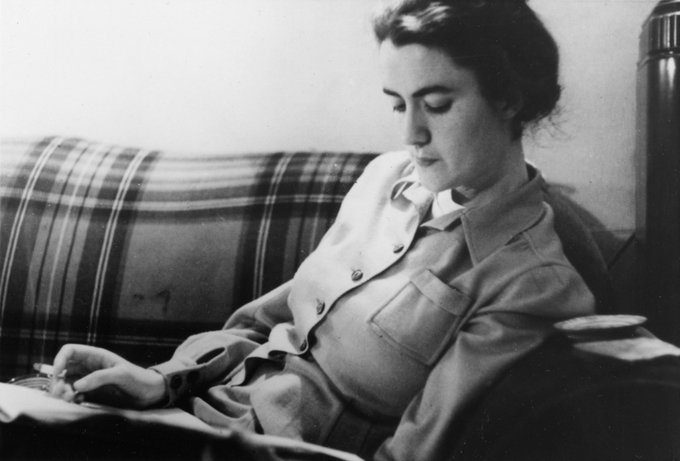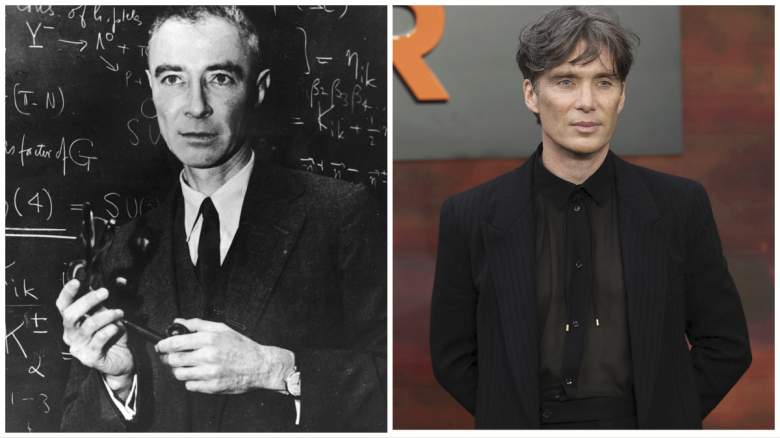
Getty Robert Oppenheimer (l) and actor Cillian Murphy.
The movie “Oppenheimer” is a biopic of sorts about the real-life scientist who ran the Manhattan Project, J. Robert Oppenheimer. Many moviegoers are leaving the theater wondering what is real and what is false in the movie.
Be forewarned that this article will contain spoilers for the movie “Oppenheimer” because it closely tracks with real events.
The movie depicts Oppenheimer as a brilliant but flawed scientist who was a womanizer and Communist Party sympathizer while helping develop the technology for the nuclear bombs that devastated the Japanese cities of Hiroshima and Nagasaki. The movie shows the Americans in a race with the Nazis to build a bomb, and it spends a lot of time exploring the moral quandaries behind unleashing such technology on the world.
In real life, Oppenheimer was married to a woman named Kitty and had a mistress named Jean Tatlock who met a tragic end.
A lengthy subplot deals with the blacklisting of Oppenheimer after World War II, with a rigged committee stripping Oppenheimer of his security clearance, effectively wrecking his career. The villain in this effort is a man named Lewis Strauss, played by Robert Downey Jr., who, in real life, was a financier who chaired the Atomic Energy Commission, according to the Atomic Heritage Foundation.
Here’s what you need to know about the real story behind Oppenheimer:
J. Robert Oppenheimer Is Known in Real Life as the ‘Father of the Atomic Bomb’

GettyAmerican physicist Dr. Robert Oppenheimer (1904 – 1967), points to a picture of the atomic bomb explosion over Nagasaki, Japan, as scientist Henry D. Smyth (1898 – 1986) (second left), major General Kenneth D. Nichols (1907 – 2000) (second right), and scientist Glenn Seaborg (1912 – 1999) look on, 1940s.
According to the Atomic Heritage Foundation, J. Robert Oppenheimer (1904-1967) “was an American theoretical physicist. During the Manhattan Project, Oppenheimer was director of the Los Alamos Laboratory and responsible for the research and design of an atomic bomb. He is often known as the ‘father of the atomic bomb.'”
The site notes:
By the time the Manhattan Project was launched in the fall of 1942, Oppenheimer was already considered an exceptional theoretical physicist and had become deeply involved in exploring the possibility of an atomic bomb. Throughout the previous year he had been doing research on fast neutrons, calculating how much material might be needed for a bomb and how efficient it might be.
He was selected by General Leslie Groves (played by Matt Damon in the movie) as director of weapons development at the Los Alamos Laboratory, and less than three years later, the U.S. dropped atomic bombs on two Japanese cities, according to the site.
According to the Institute for Advanced Study, he was born Julius Robert Oppenheimer on April 22, 1904, in New York City, and “grew up in a Manhattan apartment adorned with paintings by van Gogh, Cézanne, and Gauguin.”
“His father, Julius Oppenheimer, was a German immigrant who worked in his family’s textile importing business. His mother, Ella Friedman, was a painter whose family had been in New York for generations. His younger brother, Frank, would also become a physicist,” the site says.
“In 1921, Oppenheimer graduated from the Ethical Culture School of New York at the top of his class. At Harvard, Oppenheimer studied mathematics and science, philosophy and Eastern religion, and French and English literature,” it says.
“His lectures were a great experience, for experimental as well as theoretical physicists,” commented the late physicist Hans Bethe, according to the Institute. The Institute also quotes Bethe as saying of Oppenheimer:
In addition to a superb literary style, he brought to them a degree of sophistication in physics previously unknown in the United States. Here was a man who obviously understood all the deep secrets of quantum mechanics, and yet made it clear that the most important questions were unanswered. His earnestness and deep involvement gave his research students the same sense of challenge. He never gave his students the easy and superficial answers but trained them to appreciate and work on the deep problems.
According to the Institute, the Manhattan Project “involved several laboratories in secret locations across the country, including the University of Chicago; Oak Ridge, Tennessee; and Los Alamos, New Mexico. Oppenheimer oversaw the construction of the Los Alamos laboratory, where he gathered the best minds in physics to work on the problem of creating an atomic bomb.”
It’s True That Robert Oppenheimer’s Wife Was a Woman Named Kitty
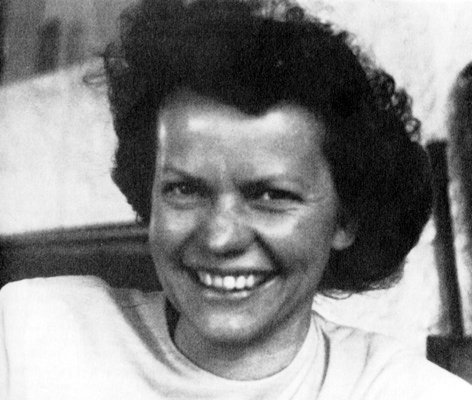
Atomic Heritage FoundationKitty Oppenheimer.
Katherine “Kitty” Oppenheimer, born Katherine Puening (1910-1972) “was a German-American botanist and wife of Los Alamos Scientific Director J. Robert Oppenheimer,” according to The Atomic Heritage Foundation.
According to that article,
Kitty was briefly a lab technician at Los Alamos under the supervision of Dr. Louis Hempelmann, but quit after a year. As a trained botanist, Kitty felt stymied professionally at Los Alamos, and instead she led an active social life. She often hosted cocktail parties for small groups of women to provide a distraction from the high-pressure environment of Los Alamos.
The article describes her personality as “fiery” and says that the couple had two children together: Peter and Toni.
As the movie presents, Oppenheimer’s wife was married before, once to a man named Frank Ramseyer (the marriage was annulled) and a second time to “a young Communist named Joe Dallet in 1934” who was killed in combat fighting for the Communists in the Spanish Civil War, according to her bio on the Atomic Heritage Foundation.
When she met Oppenheimer, she was married to husband number three, a doctor named Richard Harrison; she divorced him to marry Oppenheimer in 1940, according to the Atomic Heritage Foundation.
The article notes,
She had been questioned and monitored by security personnel at Los Alamos, and was the most obvious link between Robert and Communism. Both Robert and Kitty Oppenheimer affirmed their loyalty to the United States in testimony to the Atomic Energy Commission, but in the end, Oppenheimer was forced to forfeit his security clearance, effectively ending his career in government.
In Real Life, J. Robert Oppenheimer & Albert Einstein Did Know Each Other
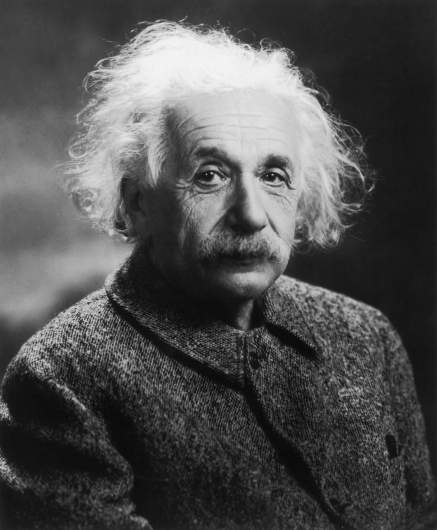
GettyGerman-born physicist Albert Einstein (1879 – 1955), who developed the Theory of Relativity. He moved to Princeton, New Jersey in 1933, when Hitler came to power, and recommended the construction of an American atomic bomb.
The movie and Einstein/Oppenheimer scenes are based on the book, American Prometheus: The Triumph and Tragedy of J. Robert Oppenheimer. According to Gamerant, the pair first met at CalTech. In the book, Oppenheimer’s father Julius reveals that his son, while “engrossed in his teaching duties at Cal Tech, found time to engage in a few fleeting discussions with Einstein,” Gamerant reports.
According to Mashable, in 1947, they worked together at the Institute for Advanced Study until Einstein died in 1955. SFGate points out that the men had different personalities and disagreements over quantam physics.
In 1966, the real Robert Oppenheimer confirmed his friendship with scientist Albert Einstein in a lecture reprinted in The New York Review.
“Though I knew Einstein for two or three decades, it was only in the last decade of his life that we were close colleagues and something of friends,” he wrote. “But I thought that it might be useful, because I am sure that it is not too soon—and for our generation perhaps almost too late—to start to dispel the clouds of myth and to see the great mountain peak that these clouds hide. As always, the myth has its charms; but the truth is far more beautiful.”
He also said, “Einstein is often blamed or praised or credited with these miserable bombs. It is not in my opinion true.” He described Einstein as “almost wholly without sophistication and wholly without worldliness… there was always with him a wonderful purity at once childlike and profoundly stubborn.”
According to the Bulletin of the Atomic Scientists, in 1939, Albert Einstein “sent a letter to U.S. President Franklin Delano Roosevelt, advising him that the process of nuclear fission could potentially be used to create a powerful atomic bomb.”
Roosevelt launched the Manhattan Project to explore creating such a bomb as a result of the letter, according to the Bulletin, which printed the letter’s full text. According to Discover Magazine, Time wrote in 1945, “Albert Einstein did not work directly on the atom bomb. But Einstein was the father of the bomb in two important ways: 1) it was his initiative which started U.S. bomb research; 2) it was his equation (E = mc2) which made the atomic bomb theoretically possible.”
Einstein said, according to the Atlantic, “I do not consider myself the father of the release of atomic energy.” According to Mashable, Einstein was not able to work on the bomb project because he was denied security clearance due to his leftist politics.
Einstein was troubled by the bomb, later telling Newsweek, “Had I known that the Germans would not succeed in producing an atomic bomb. I never would have lifted a finger.”
It’s True That a Government Security Board Stripped Robert Oppenheimer of His Security Clearance Due to Communist Party Affiliations, But the U.S. Government Later Vacated the Decision & KGB Archives Show He Wasn’t a Soviet Spy
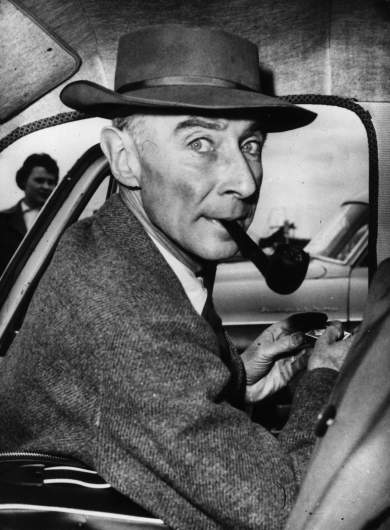
GettyAmerican atomic scientist Julius Robert Oppenheimer (1904 – 1967)
In 1954, the United States Atomic Energy Commission published, “Findings and Recommendations of the Personnel Security Board in the Matter of Dr. J. Robert Oppenheimer.”
“On December 23, 1953, Dr. J. Robert Oppenheimer was notified by letter that his security clearance had been suspended. He was furnished a list of items of derogatory information and was advised of his rights to a hearing under AEC procedures. On March 4, 1954, Dr. Oppenheimer requested that he be afforded a hearing. A hearing has been conducted by the Board appointed by you for this purpose, and we submit our findings and recommendation,” it reads.
“Dr. Ward V. Evans dissents from the recommendation of the majority of the Board, and his minority report is attached.” The findings note, “The Board approached its task in the spirit of inquiry, not that of a trial. The Board worked long and arduously. It has heard 40 witnesses including Dr. J. Robert Oppenheimer and compiled over 3,000 pages of testimony in addition to having read the same amount of file material.”
In 2022, the U.S. Government vacated the decision, finding that the hearing was flawed:
In 1954, the Atomic Energy Commission revoked Dr. Oppenheimer’s security clearance through a flawed process that violated the Commission’s own regulations. As time has passed, more evidence has come to light of the bias and unfairness of the process that Dr. Oppenheimer was subjected to while the evidence of his loyalty and love of country have only been further affirmed. The Atomic Energy Commission even selected Dr. Oppenheimer in 1963 for its prestigious Enrico Fermi Award citing his ‘scientific and administrative leadership not only in the development of the atomic bomb, but also in establishing the groundwork for the many peaceful applications of atomic energy.’
In 1995, the FBI cleared Oppenheimer of having been a Soviet spy, according to The Los Angeles Times. That article notes,
After an internal review of still classified materials, the FBI dismissed accusations made by a former senior KGB official in a recent book charging that scientists Robert Oppenheimer, Niels Bohr, Enrico Fermi and Leo Szilard were ‘witting sources of the Soviet KGB’ after World War II.
According to US News and World Report in 2009, several authors were allowed to review KGB archives, which exonerated Oppenheimer of spying. “Robert Oppenheimer continuously refused to help the KGB, much to Moscow’s frustration,” the article notes.
Among the allegations the security board deemed true:
“It was reported that in 1940 you were listed as a sponsor of the Friends of the Chinese People, an organization which was characterized in 1944 by the House Committee on Un-American Activities as a Communist-front organization.” (Oppenheimer told the board he had no recollection of the group.)
“It was further reported that in 1940 your name was included on a letterhead of the American Committee for Democracy and Intellectual Freedom as a member of its National Executive Committee. The American Committee for Democracy and Intellectual Freedom was characterized in 1942 by the House Committee on Un-American Activities as a Communist-front which defended Communist teachers, and in 1943 it was characterized as subversive and Un-American by a Special Subcommittee of the House Committee on Appropriations.” (Oppenheimer testified that when he joined this group, “He said that it then stood as a protest against what had happened to intellectuals and professionals in Germany.”)
“It was further reported that in 1938 you were a member of the Western Council of the Consumers Union. The Consumers Union was cited in 1944 by the House Committee on Un-American Activities as a Communist-front headed by the Communist Arthur Kallet.” (Oppenheimer admitted having been a member of this group.)
The document also states:
It was further reported that you stated in 1943 that you were not a Communist, but had probably belonged to every Communist-front organization on the west coast and had signed many petitions in which Communists were interested.
The Board concludes that this statement was made by Dr. Oppenheimer, and the Board had before it considerable evidence indicating Dr. Oppenheimer’s membership in, and association with, Communist-front organizations and activities on the west coast. However, Dr. Oppenheimer, in his answer, claimed that the quotation was not true and that if he had said anything along the lines quoted, it was a half-jocular overstatement.
The document contains a list of other allegations.
It’s True That Robert Oppenheimer’s Mistress Was a Communist Party Member Named Jean Tatlock
According to the personnel security board’s findings, “It was reported that in 1943 and previously you were intimately associated with Dr. Jean Tatlock, a member of the Communist Party in San Francisco, and that Dr. Tatlock was partially responsible for your association with Communist-front groups.”
The Board concluded “that this allegation is true,” noting,
Dr. Oppenheimer in his testimony before this Board admitted having associated with Jean Tatlock from 1936 until 1943. He stated that he saw her only rarely between 1939 and 1943, but admitted that the association was intimate. He admitted having seen Jean Tatlock under most intimate circumstances in June or July of 1943, during the time when he was Director of the Los Alamos Laboratory, and admitted that he knew she had been a Communist and that there was not any reason for him to believe that she was not at that time still a Communist. He named several Communists, Communist functionaries or Communist sympathizers whom he had met through Jean Tatlock, or as a result of his association with her.
The book on Oppenheimer states of Tatlock, “Jean was Robert’s truest love. He loved her the most. He was devoted to her.”
According to the Atomic Heritage Foundation, “Tatlock met J. Robert Oppenheimer in 1936 while she was studying at the Stanford University Medical School. By this point, she was already an active member of the Bay Area’s Communist community. She is credited with introducing Oppenheimer to this community, initiating his connections to radical politics that would eventually lead to the revocation of his security clearance almost twenty years later.”
The article notes, “Tatlock broke off the relationship in 1939, but Oppenheimer visited her in San Francisco as late as 1943. Tatlock, who suffered from depression, was found dead on January 5, 1944. Some have suggested foul play was the cause, but most historians have concluded that she most likely committed suicide.”
According to Nuclear Secrecy blog, citing the American Prometheus book, “Tatlock’s father discovered her dead, having broken into her apartment after a day of not being able to reach her. He found her ‘lying on a pile of pillows at the end of the bathtub, with her head submerged in the partly filled tub.'”
The blog continues,
He found her suicide note, which read: ‘I am disgusted with everything… To those who loved me and helped me, all love and courage. I wanted to live and to give and I got paralyzed somehow. I tried like hell to understand and couldn’t… I think I would have been a liability all my life—at least I could take away the burden of a paralyzed soul from a fighting world.’
The American Prometheus authors wrote:
According to the coroner, Tatlock had eaten a full meal shortly before her death. If it was her intention to drug and then drown herself, as a doctor she had to have known that undigested food slows the metabolizing of drugs into the system. The autopsy report contains no evidence that the barbiturates had reached her liver or other vital organs. Neither does the report indicate whether she had taken a sufficiently large dose of barbiturates to cause death. To the contrary, as previously noted, the autopsy determined that the cause of death was asphyxiation by drowning. These curious circumstances are suspicious enough—but the disturbing information contained in the autopsy report is the assertion that the coroner found ‘a faint trace of chloral hydrate’ in her system. If administered with alcohol, chloral hydrate is the active ingredient of what was then commonly called a ‘Mickey Finn’—knockout drops. In short, several investigators have speculated, Jean may have been ‘slipped a Mickey,’ and then forcibly drowned in her bathtub.
Werner Heisenberg Was Really the Leading Nazi Scientist, but the Germans Weren’t That Close to Getting an Atomic Bomb
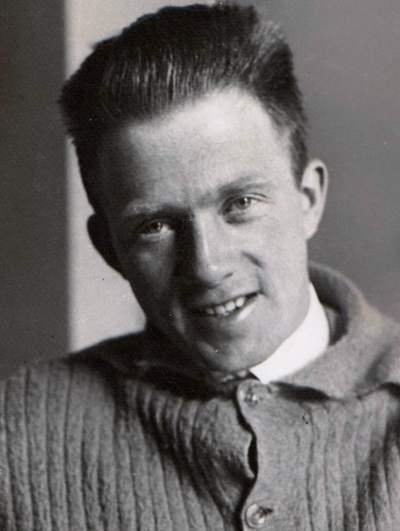
Wikimedia CommonsWerner Heisenberg.
In the movie, the Americans are pressured by the belief that the Nazis, led by scientist Werner Heisenberg, were close to getting the Atom bomb. In real life, this was not true.
“Physicist Werner Heisenberg hid information from Nazi leaders about how to build an atomic bomb,” according to New Scientist.
According to New Scientist, Heisenberg “wrote in Nature that there were simple practical reasons why Germany never embarked on a full-scale bomb programme. Under wartime conditions, it would have been impossible to build the huge industrial infrastructure of the US’s Manhattan Project. But he also wrote that the physicists themselves ‘had consciously striven to keep control of the project’ and avoided work on a bomb, preferring to work on reactors and cyclotrons.”
The Atomic Bombs Killed Tens of Thousands of People at Hiroshima & Nagasaki
According to History.com, in 1945, “The explosion immediately killed an estimated 80,000 people; tens of thousands more would later die of radiation exposure. Three days later, a second B-29 dropped another A-bomb on Nagasaki, killing an estimated 40,000 people.”
The Japanese emperor subsequently surrendered. According to History.com, Japan was even more lethal when facing sure defeat: “In fact, between mid-April 1945 (when President Harry Truman took office) and mid-July, Japanese forces inflicted Allied casualties totaling nearly half those suffered in three full years of war in the Pacific, proving that Japan had become even more deadly when faced with defeat.”
According to Live Science, the bomb left black shadows of people who were vaporized throughout the Japanese cities.
READ NEXT: Werner Heisenberg: How Close Were Nazis to Getting the Atom Bomb?
